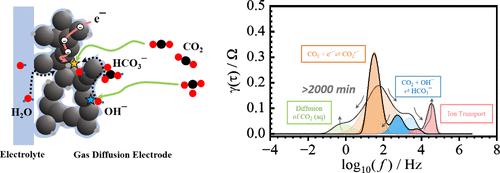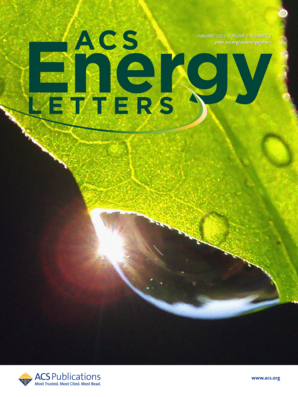对低温二氧化碳电还原过程中的性能退化进行先进的阻抗分析
IF 18.2
1区 材料科学
Q1 CHEMISTRY, PHYSICAL
引用次数: 0
摘要
电化学阻抗光谱(EIS)是研究电化学系统常用的一种强大工具。然而,由于二氧化碳电还原反应的机理和环境十分复杂,迄今为止,它在二氧化碳电还原中的应用还很有限。尽管初步研究结果表明在二氧化碳电解槽中应用 EIS 分析是可行的,但阻抗谱中各个过程的分配仍然模糊不清。因此,必须进行更详细的研究,特别是重点研究其在评估降解机制中的应用。本研究开发了一种稳定的气体扩散电极 (GDE) 系统,用于全面评估 EIS 和弛豫时间分布 (DRT),以评估高电流密度和低操作温度等加速应力条件下的关键降解机制。通过死后分析和补充方法的验证,我们证明了这种方法的可行性,即通过指定 GDE 中的单个机理过程并将其与随时间变化的性能退化联系起来,从而对二氧化碳电还原进行操作监测。本文章由计算机程序翻译,如有差异,请以英文原文为准。

Advanced Impedance Analysis for Performance Degradation during Low-Temperature CO2 Electroreduction
Electrochemical impedance spectroscopy (EIS) is a powerful tool commonly used to study electrochemical systems. Nevertheless, its application in CO2 electroreduction has been so far limited due to its complex reaction mechanism and environment. Although initial findings have demonstrated the viability of applying EIS analysis in CO2 electrolyzers, the assignment of individual processes in the impedance spectra remains ambiguous. Therefore, a more detailed investigation, especially focused on its application in evaluating degradation mechanisms, is essential. In this study, a stable gas diffusion electrode (GDE) system was developed for a comprehensive EIS and distribution of relaxation time (DRT) evaluation to assess key degradation mechanisms under accelerated stress conditions such as high current density and low operating temperature. Validated by post-mortem analysis and complementary methods, we demonstrate the viability of this approach for operando monitoring of CO2 electroreduction by assigning individual mechanistic processes in the GDE and linking them to performance degradation over time.
求助全文
通过发布文献求助,成功后即可免费获取论文全文。
去求助
来源期刊

ACS Energy Letters
Energy-Renewable Energy, Sustainability and the Environment
CiteScore
31.20
自引率
5.00%
发文量
469
审稿时长
1 months
期刊介绍:
ACS Energy Letters is a monthly journal that publishes papers reporting new scientific advances in energy research. The journal focuses on topics that are of interest to scientists working in the fundamental and applied sciences. Rapid publication is a central criterion for acceptance, and the journal is known for its quick publication times, with an average of 4-6 weeks from submission to web publication in As Soon As Publishable format.
ACS Energy Letters is ranked as the number one journal in the Web of Science Electrochemistry category. It also ranks within the top 10 journals for Physical Chemistry, Energy & Fuels, and Nanoscience & Nanotechnology.
The journal offers several types of articles, including Letters, Energy Express, Perspectives, Reviews, Editorials, Viewpoints and Energy Focus. Additionally, authors have the option to submit videos that summarize or support the information presented in a Perspective or Review article, which can be highlighted on the journal's website. ACS Energy Letters is abstracted and indexed in Chemical Abstracts Service/SciFinder, EBSCO-summon, PubMed, Web of Science, Scopus and Portico.
 求助内容:
求助内容: 应助结果提醒方式:
应助结果提醒方式:


